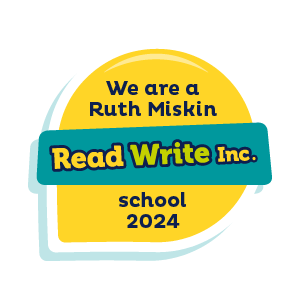PHONICS AND EARLY READING
At Ravenfield Primary Academy we teach children to read and spell by using the Read Write Inc approach to the teaching of phonics. Read Write Inc., developed by Ruth Miskin, provides a structured and systematic approach to teaching literacy. It is used by more than a quarter of the UK's primary schools and is designed to create fluent readers, confident speakers and willing writers.
Read Write Inc. Phonics is a complete literacy programme, for 4 to 7 year-olds learning to read and write and for 7 and 8 year-olds needing to catch up quickly.
Programme progression:
IN FOUNDATION STAGE 2 CHILDREN WILL...
- Read storybooks and non-fiction books closely matched to their developing phonic knowledge
- Take home Phonics storybooks to share
- Read with fluency and expression
- Learn to spell using known sounds
- Write confidently by practising what they want to write out loud first
- Work well with a partner.
BY THE END OF YEAR 1 CHILDREN ARE...
- Accurate and speedy readers and are ready to move onto the Literacy and Literacy Programme.
BY THE END OF YEAR 2 CHILDREN ARE...
- Able to access a range of books and are able to talk about the stories they read.
IN KEY STAGE 2 CHILDREN WILL...
- Read, think and talk about a wide range of high quality texts through the reciprocal reading approach.
RESOURCES
If you have further questions or want resources to help your child, either call in to school or follow the following links:
- Read Write Inc Website: http://www.ruthmiskin.com/en/parents/
- Phonics Play Website: http://www.phonicsplay.co.uk/
- BBC Bitesize:http://www.bbc.co.uk/bitesize/ks1/literacy/phonics/play/
WHAT IS PHONICS?
There has been a huge shift in the past few years in how we teach reading in UK schools. This is having a big impact and helping many children learn to read and spell. Phonics is recommended as the first strategy that children should be taught in helping them learn to read. It runs alongside other teaching methods to help children develop all the other vital reading skills and hopefully give them a real love of reading.
Phonics are words made up from small units of sound called phonemes. Phonics teaches children to be able to listen carefully and identify the phonemes that make up each word. This helps children to learn to read words and to spell words.
WHAT ARE CHILDREN TAUGHT IN PHONICS LESSONS
GPCs
They are taught GPCs. This stands for grapheme phoneme correspondences. This simply means that they are taught all the phonemes in the English language and ways of writing them down. These sounds are taught in a particular order. The first sounds to be taught are s, a, t, p.
Blending
Children are taught to be able to blend. This is when children say the sounds that make up a word and are able to merge the sounds together until they can hear what the word is. This skill is vital in learning to read.
Segmenting
Children are also taught to segment. This is the opposite of blending. Children are able to say a word and then break it up into the phonemes that make it up. This skill is vital in being able to spell words.
WHAT MAKES PHONICS TRICKY?
In some languages learning phonics is easy because each phoneme has just one grapheme to represent it. The English language is a bit more complicated than this. This is largely because England has been invaded so many times throughout its history. Each set of invaders brought new words and new sounds with them. As a result, English only has around 44 phonemes but there are around 120 graphemes or ways of writing down those 44 phonemes. Obviously we only have 26 letters in the alphabet so some graphemes are made up from more than one letter.
ch th oo ay (these are all digraphs - graphemes with two letters)
There are other graphemes that are trigraphs (made up of 3 letters) and even a few made from 4 letters.
Another slightly sticky problem is that some graphemes can represent more than one phoneme. For example ch makes very different sounds in these three words: chip, school, chef.
WHY DO WE TEACH PHONICS?
In the past people argued that because the English language is so tricky, there was no point teaching children phonics. Now, most people agree that these tricky bits mean that it is even more important that we teach phonics and children learn it clearly and systematically. A written language is basically a kind of a code. Teaching phonics is just teaching children to crack that code. Children learn the simple bits first and then easily progress to get the hang of the trickier bits.


